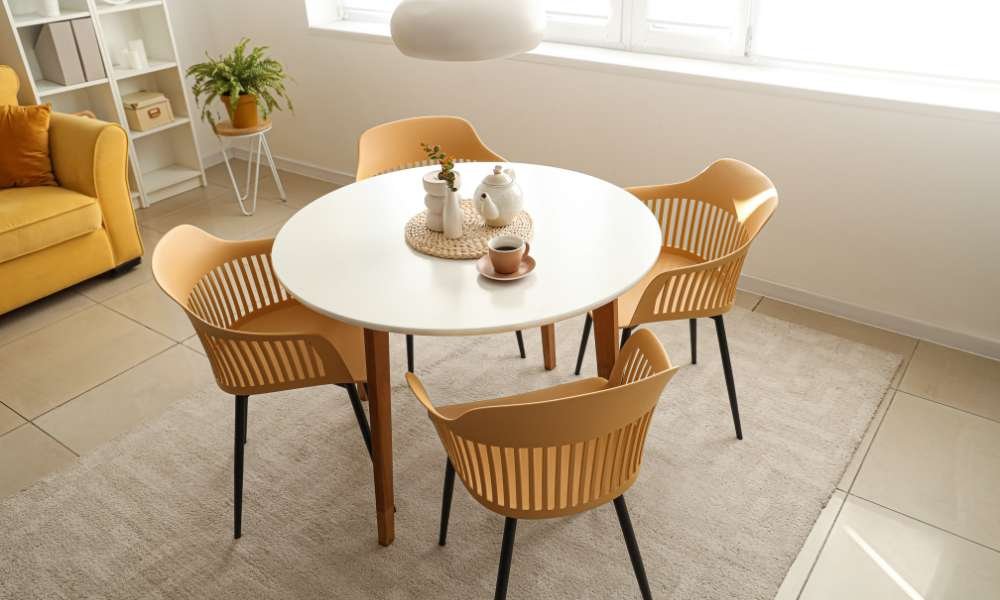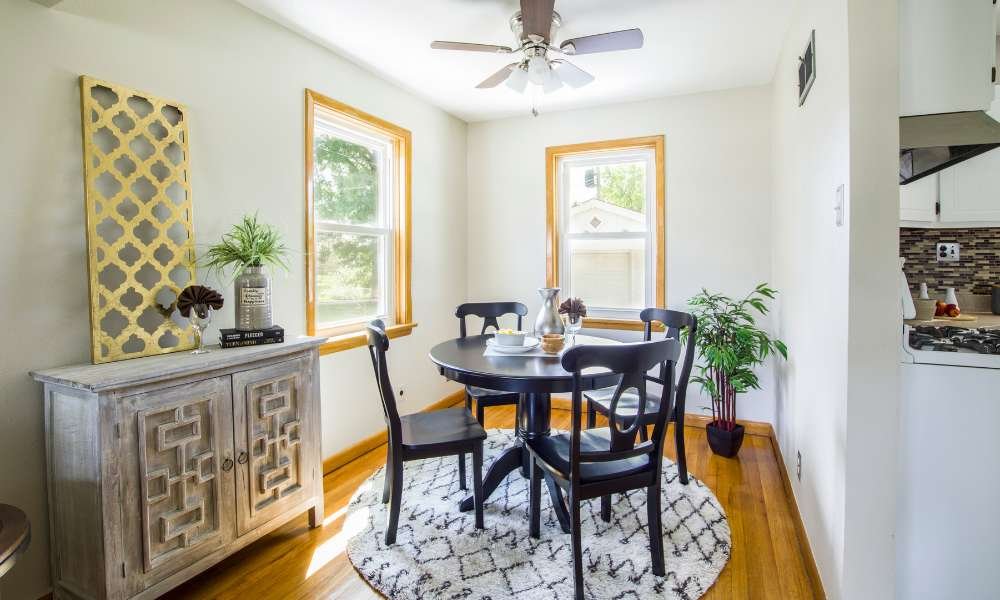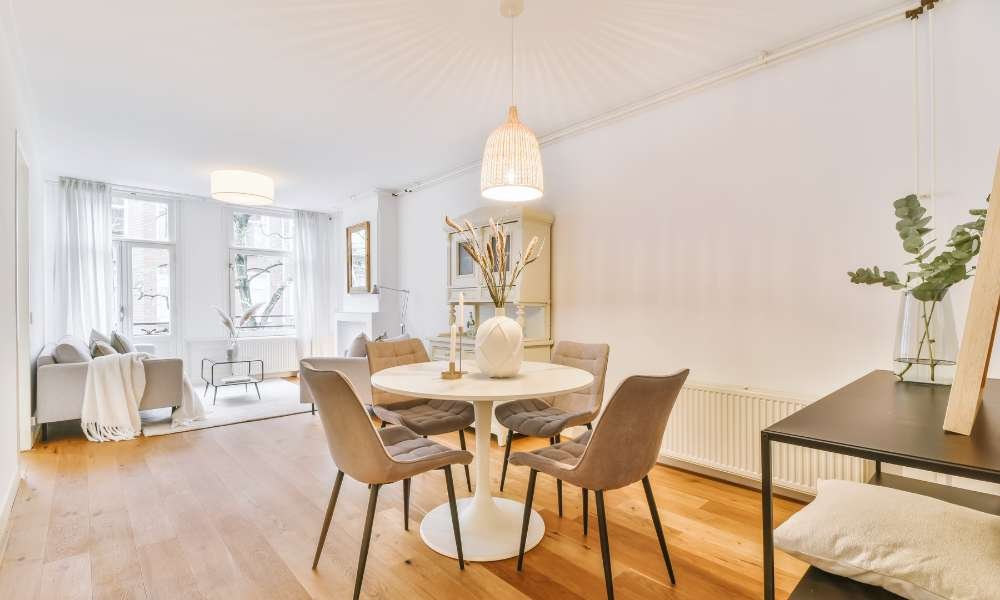Selecting the right size rug for your dining table is crucial in defining the aesthetics and functionality of your dining area. An appropriately sized rug not only complements the table but also harmonizes with the overall room dimensions, enhancing the beauty and balance of the space. It frames the dining area, providing a visual anchor that brings cohesiveness to your decor. Moreover, the choice involves considering various factors such as the size of the table, the dimensions of the room, and the shape of the rug. Each element plays a pivotal role in ensuring that the carpet enhances both comfort and style in your dining room.
Why Choosing the Right Rug Size Matters
Choosing the correct carpet size for your dining table is essential for optimizing both aesthetics and functionality. A well-proportioned rug enhances the feasting experience by unifying the space’s visual elements and creating a warm, inviting atmosphere. Conversely, an incorrectly sized rug can lead to several issues. A carpet that is too small may not accommodate all dining chairs comfortably, leading to an awkward and unbalanced look. Moreover, a rug that is too large or improperly placed can become a tripping hazard, posing safety risks. Therefore, selecting the right carpet size is critical to maintaining both the beauty and the safety of your feasting area.
Standard Rug Sizes for Dining Tables
When choosing a rug for your dining table, it’s essential to consider the standard sizes available and how they align with your table dimensions. Common rug sizes include 5×8, 6×9, 8×10, and 9×12 feet. Smaller tables that accommodate four people fit well with a 5×8 or 6×9 feet rug, ensuring all chairs remain on the carpet when pulled out. For larger tables that seat six to eight people, an 8×10 feet carpet is ideal, providing ample space for chairs and preventing any imbalance. The largest size, 9×12 feet, suits expansive dining areas with tables that seat eight or more, offering extensive coverage and enhancing room aesthetics. Selecting the correct rug size enhances functionality and harmony in your feasting space.
Matching Rug Size to Dining Table Shape
Choosing the right rug shape to complement your dining table can significantly enhance the room’s aesthetics. For rectangular dining tables, a rectangular carpet aligns seamlessly, emphasizing the table’s linear structure and maintaining balance. Round tables often pair best with round rugs, creating a soft, unified look that highlights the table’s curvature. Square tables are ideally complemented by square rugs, which reinforce the symmetry and proportions of the feasting setup. Matching the rug shape to your table not only boosts visual appeal but also ensures that the dining area feels thoughtfully curated and spatially harmonious, making every meal a visually pleasing experience.
Measuring the Dining Area for a Rug
Accurately measuring your dining area is critical to selecting the perfect rug size. Begin by measuring the length and width of your feasting table. Then, add at least 24 inches on each side to accommodate chair movement, ensuring chairs remain on the carpet when pulled out. This extra space prevents chairs from catching on the edge of the rug, which can cause wear and tear and make seating uncomfortable. For accuracy, use a tape measure and record dimensions in both directions. By considering chair movement and table dimensions, you’ll choose acarpet that enhances both the functionality and aesthetics of your feasting space, making it both inviting and practical.
Common Rug Size Mistakes to Avoid
One of the most frequent carpet sizing errors is choosing a rug that’s too small for the dining area, which can make the space feel disjointed and cramped. Conversely, selecting a rug that’s too large can overwhelm the room and make it appear smaller. To avoid these pitfalls, ensure the carpet is large enough to accommodate all feasting chairs when pulled out but not so extensive that it encroaches on walking paths or other furniture. Always measure your dining table and account for an additional 24-30 inches around the table for chair movement. By adhering to these guidelines, you’ll achieve a balanced look that enhances both comfort and style in your feasting room.
Factors to Consider When Choosing a Rug Size
Selecting the right carpet what size rug for dining table involves more than just measuring the table itself; it requires a consideration of the entire room’s layout. The size of the room dictates the maximum carpet size that can comfortably fit without overwhelming the space. Similarly, the table size and the number of chairs determine the minimum carpet dimensions needed to ensure all chairs stay on the carpet even when pulled out. Also, consider the room’s overall layout, including the placement of other furniture and walking paths. Balancing these elements ensures that your carpet enhances the functionality and aesthetic appeal of the dining area, creating a cohesive and inviting space.
Rug Materials and Their Impact on Rug Size
The material of a dining room carpet not only affects its durability and feel but can also influence the size and practicality of the carpet choice. Wool rugs, known for their durability and stain resistance, are ideal for busy feasting areas and can come in larger sizes without sacrificing comfort. Synthetic materials, such as nylon or polyester, offer versatility and are easier to clean, making them suitable for under feasting tables where spills are common. Cotton rugs are lightweight and lend themselves to smaller sizes, which are easier to wash and handle. When selecting a carpet, consider how the material will interact with your feasting space’s size and usage to ensure optimal functionality and aesthetic fit.
Popular Rug Styles for Dining Rooms
Choosing a carpet style that complements your dining room décor can transform the space and elevate its overall aesthetic. Modern rugs often feature clean lines and geometric patterns, making them ideal for contemporary feasting spaces. Traditional rugs, with their intricate designs and rich colors, add a touch of elegance to classic feasting rooms. Bohemian rugs, characterized by vibrant hues and eclectic patterns, can inject personality and charm into eclectic or rustic dining areas. For a coastal or farmhouse feel, consider a natural fiber rug, such as jute or sisal, which brings texture and warmth. Selecting a carpet style that aligns with your feasting room décor creates a cohesive and inviting space perfect for dining and entertaining.
Cleaning and Maintenance of Dining Room Rugs
Proper cleaning and maintenance of feasting room rugs are crucial for extending their lifespan and maintaining their appearance. For regular maintenance, vacuum the carpet weekly to remove crumbs and dust, and address spills immediately to prevent stains. Larger rugs might require professional cleaning services due to their size and weight, making them difficult to handle at home. Conversely, smaller rugs can often be cleaned at home, potentially even in a washing machine if the material allows. Regardless of size, rotate your carpet periodically to ensure even wear. Implementing these care practices will keep your feasting room carpet looking fresh and vibrant, enhancing your dining area’s overall aesthetic.
Conclusion
Selecting the perfect carpet what size rug for dining table is essential for enhancing both the functionality and aesthetics of your dining area. Remember to measure your table and account for additional space for chair movement, ensuring all chairs remain comfortably on the rug even when pulled out. Consider the room’s size, the table’s shape, and the carpet material and style that best complement your feasting room’s decor. Each dining space is unique, so tailor your choice to fit your specific needs, creating a harmonious and inviting dining environment. By carefully considering these factors, you can select a carpet that not only looks great but also serves its purpose beautifully.



